Last week’s blog post introduced the life and work of artist Virgil Cantini and highlighted the vulnerable position of postwar public art objects and installations, which often require special expertise to understand and articulate their significance for preservation.
This week’s post recounts part of the struggle to save one of Cantini’s largest works of public art, which came dangerously close to disappearing forever.
The Legacy of Urban Renewal in Pittsburgh
In April 2016, a $20 million USDOT Transportation Investment Generating Economic Recovery (TIGER) Grant was awarded to the I-579 Cap Project for a proposal designed to span the multiple sunken lanes of the I-579 Crosstown Boulevard with a park and to re-establish the physical link between Downtown Pittsburgh and Hill District.
The connection between these two neighborhoods was severed during the postwar urban renewal era known as the Pittsburgh Renaissance. The Pittsburgh Renaissance refers to a collection of wide-ranging initiatives that sought to remedy problems facing the city of Pittsburgh immediately following World War II, including infamous pollution, frequent flooding, congested traffic, and blighted neighborhoods.
An influential group of politicians, business people, and financiers collaborated to reshape the City. Among the early projects to be started were the creation of Point State Park and Gateway Center at the confluence of the three rivers; several high-profile building projects downtown; the construction of a new system of highways, bridges, and tunnels to accommodate automobile demands; smoke control and air pollution control measures; a network of dams and reservoirs to effect flood control; and various widespread urban renewal efforts.
The Pittsburgh Renaissance received national attention and many of its early initiatives were deemed to be great successes. A map produced by the Allegheny Conference on Community Development in 1956 presents an impressive selection of Pittsburgh Renaissance projects that were either already planned or in progress.
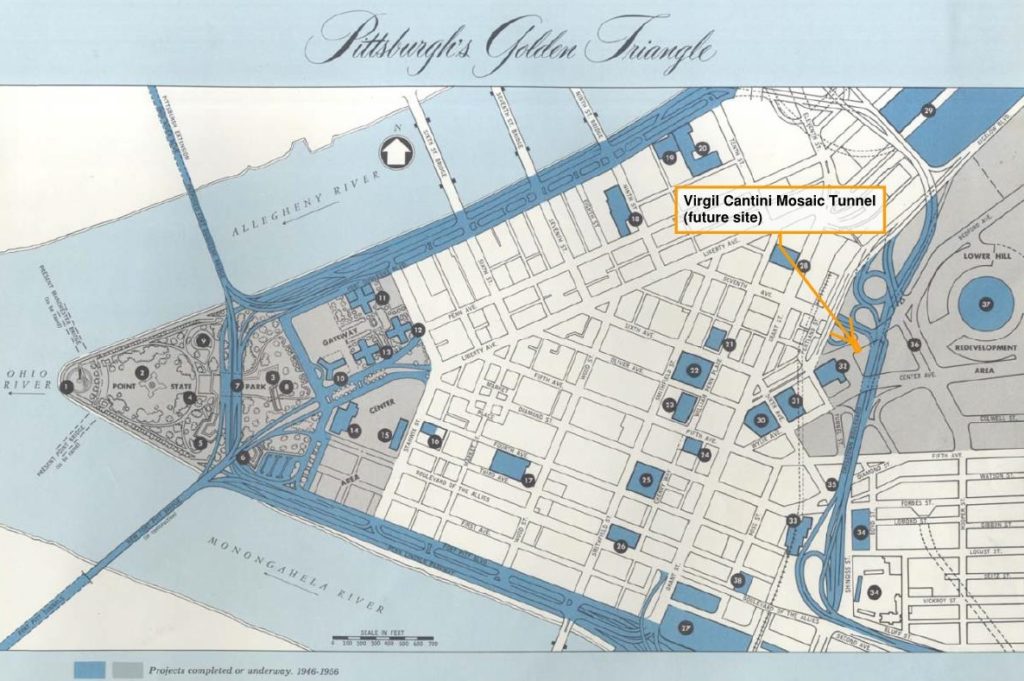
In addition to the redevelopment scheme at the Point (shown in gray at left) and the network of new and proposed highway infrastructure (shown in blue), the map reveals a portion of the area planned for the Lower Hill Redevelopment (shown in gray at right).
Lower Hill Redevelopment
The Lower Hill Redevelopment was a planned urban renewal effort that encompassed a total of 100 acres and 1,300 buildings, which housed 413 businesses and 8,000 residents.
Begun in 1955, the redevelopment was intended by its proponents to “foresee the realization of a long cherished hope. This gigantic redevelopment involves rehousing families in decent homes, erasing the City’s worst slum, erecting a long-needed auditorium-convention hall and opening the way for apartments in a park-like setting adjacent to the Triangle” (ACCD 1956:12).
Instead, it is widely understood to be a classic example of an urban renewal “failure”. The ambitious plans for the Lower Hill District were never fully realized. The homes and businesses of the Lower Hill were demolished and cleared for the construction of the Civic Arena, which was built [and has now been demolished], apartment towers that were only partly built, and a grand Center for the Arts program, which was never built.
The impact of the huge number of people (mostly African Americans and recent immigrants) displaced from their homes and businesses in the Lower Hill and the obliteration of that once thriving cultural center has had a lasting negative effect on the city. But, in 1959, when Virgil Cantini first learned of the pedestrian tunnel project, both the Pittsburgh Renaissance and Lower Hill Redevelopment Project must have seemed full of promise.
To the observant, however, the intention that the Lower Hill Redevelopment would “extend the Golden Triangle by almost one-third” was already hampered by the planned route of the broad multi-lane Crosstown Boulevard (present day I-579) that presented a very real barrier between Pittsburgh’s Downtown and the Lower Hill District.
The I-579 Cap project’s ambitious proposal was intended to heal these old wounds and reconnect the neighborhoods through a shared space with a park, an amphitheater, recreation areas, and “embedded art”.
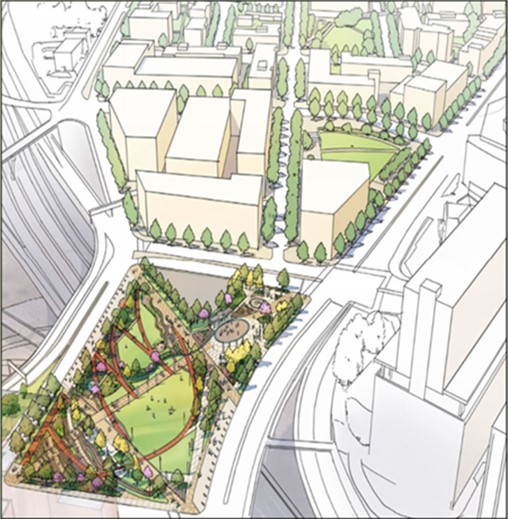
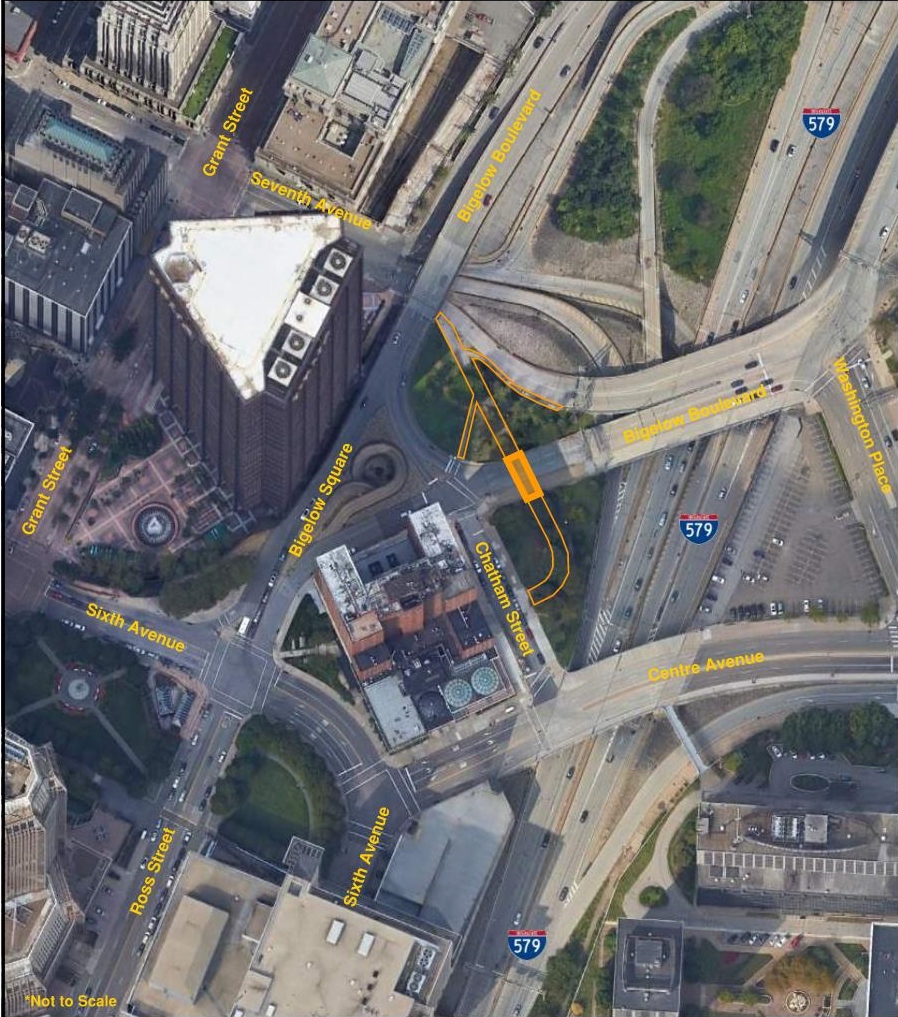
It meant to remedy the negative consequences of that urban renewal initiative, however, it also threatened the existence of a major work of public art in the City that came out of that effort in 1964. As one of the few demonstrable successes of the Lower Hill Redevelopment initiative, Virgil Cantini’s Mosaic Tunnel was a site-specific installation of 28 vibrant abstract mosaic panels in an underground pedestrian tunnel that embodied the optimism in modernity that characterized the best of the Pittsburgh Renaissance endeavors.
Appreciating Cantini’s Mosaic Tunnel
Commissioned by one of the directors of the redevelopment effort, Virgil Cantini designed his Mosaic Tunnel to be part of the City’s future.
He created 28 mosaic panels that were mounted in the pedestrian tunnel with their position, pacing, arrangement, and surrounding treatments all conforming to his artistic vision for the work. Mosaic artworks are most often created with a relatively uniform surface that is covered entirely by small pieces of stone, tile, or glass called tesserae; the tesserae are embedded in a substrate and arranged to create a colorful pattern or image.
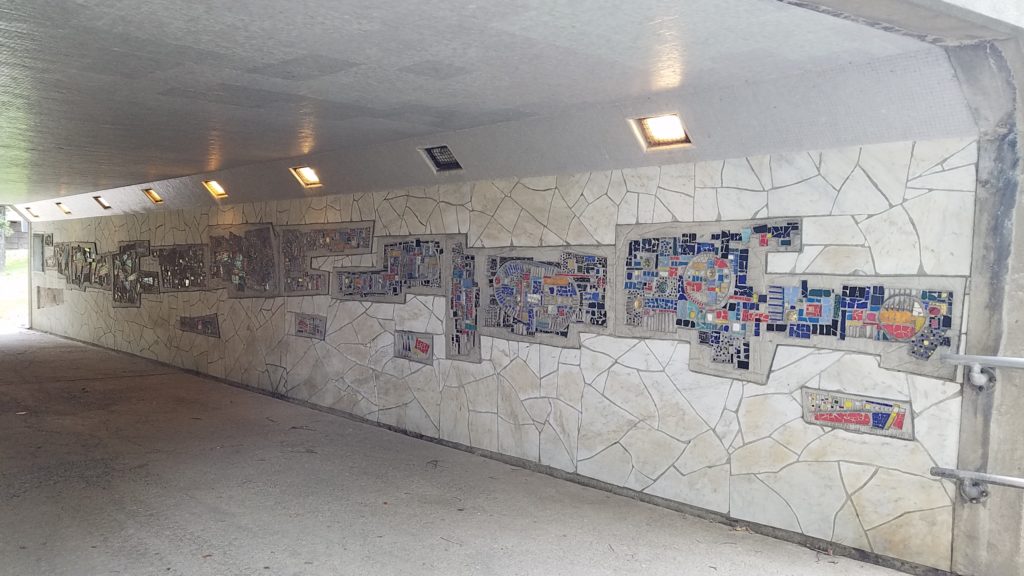
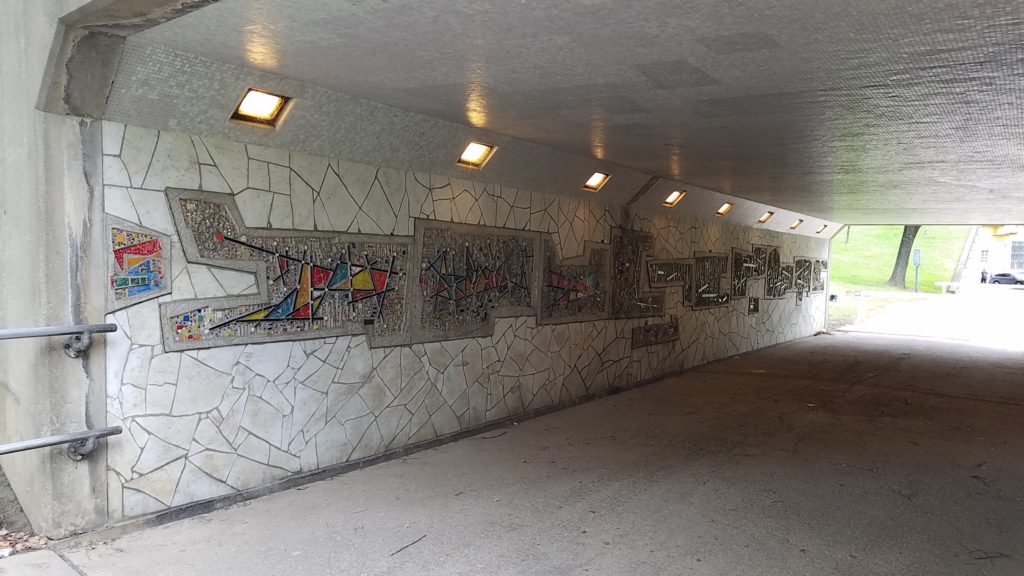
In the case of Virgil Cantini’s Mosaic Tunnel, the artwork is more accurately described as a combination of both sculpture and mosaic. The Mosaic Tunnel consists of low relief concrete sculpture panels that are accented and enlivened by the application of mosaics of colorful pieces of tile and glass to create form, texture, and pattern.
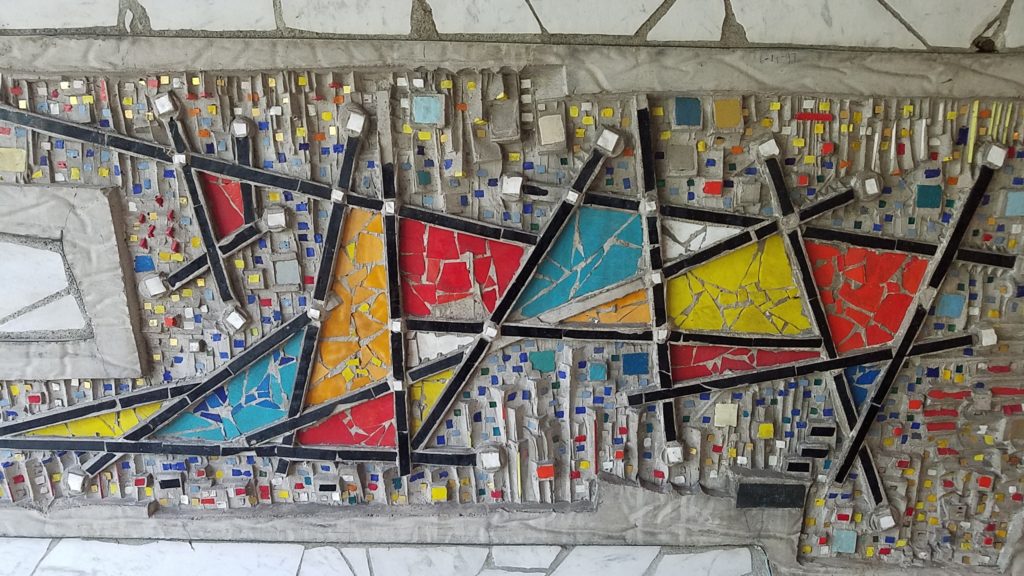
Within the concrete frame of the panels, there is typically a highly worked concrete surface that is shaped to form ribs and ridges, terraced levels and platforms, concave and convex circles, striations, starbursts, knobs, and other geometric shapes. Opaque, translucent, metallic, and pearlized tiles are then embedded in the formed concrete. Some tesserae are positioned roughly parallel to the surface of the work; some are angled to catch the light; and some tiles are installed perpendicular to the work surface highlighting the sculptural depth of the panels.
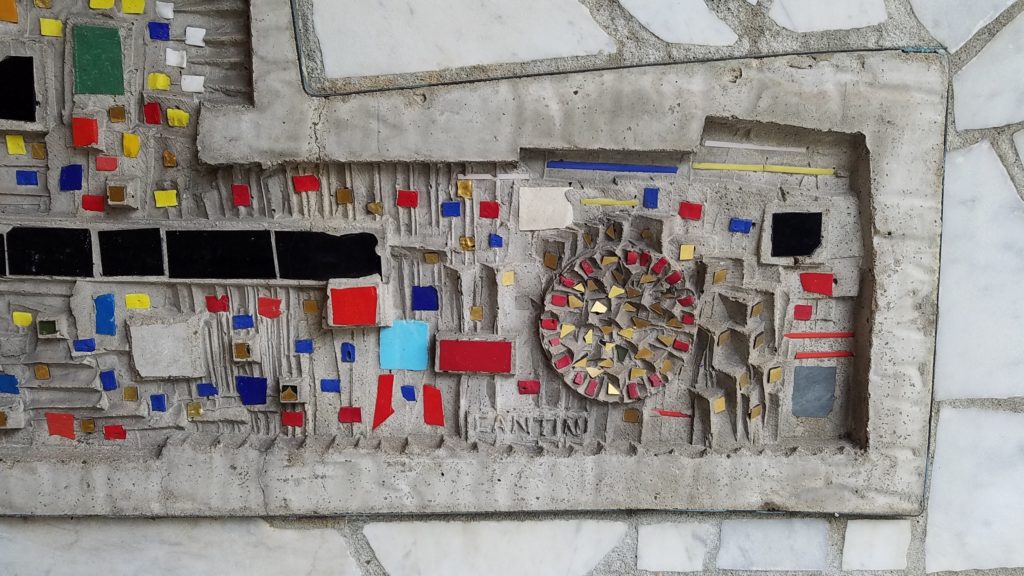
Cantini’s descriptions of the abstract artwork describe it as a way to “visualize the city simultaneously from many points of view” and as a “ribbon of light” that celebrates the City.
While the Mosaic Tunnel was loved by many, it was not broadly understood within this context when it had the potential to be adversely affected by the I-579 Cap Project. When it was learned at a late stage in the design of the I-579 Cap that the park structure arching up and over the highway would necessarily result in the burying of the underground pedestrian tunnel, there was an outcry by a small but savvy and diverse group of concerned citizens, who knew the importance of the artwork.
An early and insufficient gesture to reuse just three of the twenty-eight mosaic panels in the park’s design was rejected by the group, who became organized as consulting parties to advocate for Cantini’s work as part of the project’s consideration of effects to historic properties. The early phases of this consultation were spent trying to convince project decision makers that the Mosaic Tunnel they had overlooked, disregarded, and misunderstood was of enduring value to the City and eligible for listing in the National Register of Historic Places, requiring consideration under Section 106 of the National Historic Preservation Act, as amended.
The first evaluation of the eligibility of the work for listing in the National Register of Historic Places lacked the grounding and expertise to recognize Cantini’s standing, the Mosaic Tunnel’s importance in his body of work, and its position as an exemplary piece of site-specific public art from the urban renewal period. The second attempt resulted in agreement that the mosaic was eligible for listing in the National Register but erroneously held that the relationship of the mosaics to their site was not significant.
At each step, the consulting parties drew on their own expertise as artists, architects, designers, planners, archivists, and as members of the artist’s family to provide the research, evidence, and interpretation to challenge these shortsighted evaluations. Through no small effort, the consulting parties brought the key players involved in the project to a deeper and richer understanding of the value and significance of the artwork.
Coalition to save the Mosaic Tunnel
This hard-won understanding and consensus about the value of Cantini’s work was finally achieved too late to abandon the I-579 Cap Project but with just enough time to develop a plan to save the mosaics.
Through dozens of collaborative discussions, a legally binding document was formulated and agreed upon to provide multiple protections for the artwork. Stipulations included:
- the documentation of the Mosaic Tunnel in its original setting with high quality photographs and drone video;
- the creation of a character defining features document and a revised National Register eligibility form (still pending) to educate others about the mosaic;
- the careful removal of the 28 mosaic panels by a qualified art conservator followed by crating, storage, and eventual relocation; and
- the identification through consultation of an appropriate reinstallation site for the mosaic panels somewhere within the City of Pittsburgh.
The importance of transparency and communication among all concerned parties was finally understood to be so paramount to the success of the project that the legally binding Programmatic Agreement with all its contingencies mentions 21 different times where ongoing consultation with the consulting parties is mandated.
The extraordinary work to save the mosaics through consultation and the Section 106 Process was recognized with a national Citation of Merit Award for Advocacy from Docomomo US in December 2020.
Hope for the Future of the Mosaic Tunnel and Other At-Risk Artworks
Following the April 2019 successful removal and crating of the mosaic panels by conservators from McKay Lodge Art Conservation Laboratory, the City of Pittsburgh has provided safe storage of the artwork and has hired consultants to study the best potential relocation sites for the complete mosaic program.
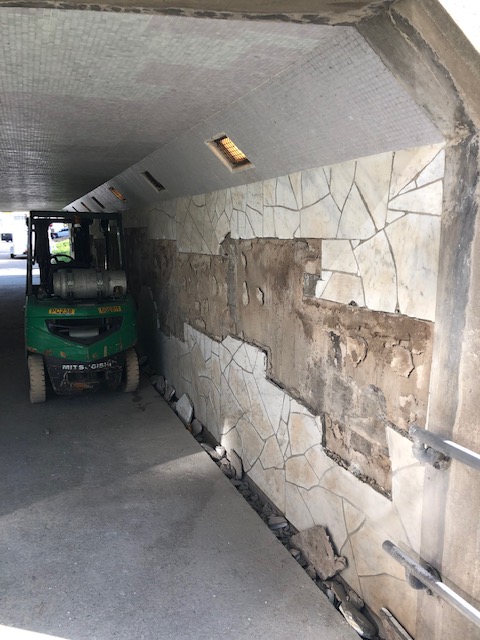
They are charged, among other things, with a robust community outreach component, which will hopefully communicate the significance of the artwork as well as its joy in celebrating modernity and the City to its new and returning audiences.
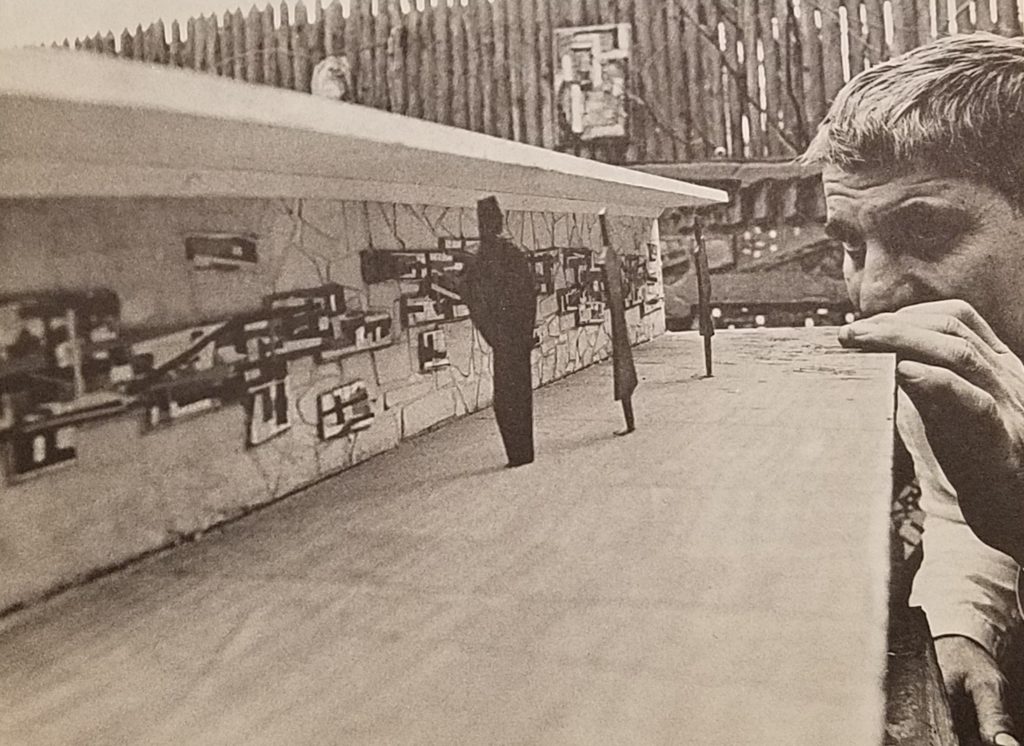
Cited References
Allegheny Conference on Community Development (ACCD). 1956. Allegheny Conference on Community Development Presents … Pittsburgh and Allegheny County: An Era of Progress and Accomplishment. Allegheny Conference on Community Development, Pittsburgh, PA. Website at http://www.andrew.cmu.edu/user/ma1f/ACCD.pdf. Accessed August 10, 2018.
Google Earth. Aerial imagery of Pittsburgh, Pennsylvania. Website at https://www.google.com/earth/. Accessed February 11, 2019.
Knox, Helen. 1964. “Tunnel of Art Is Work of Love” Pitt [Magazine]. April 1964, pages 8-10.
Sports & Exhibition Authority pf Pittsburgh Allegheny County (SEA). 2019. I-579 CAP Urban Connector Project. Website at http://www.pgh-sea.com/index.php?path=i5-ucp. Accessed February 8, 2021.
Today’s guest contributor is Laura Rickets, Senior Architectural Historian with The Markosky Engineering Group, Inc.
Comment Policy
PHMC welcomes and encourages topic-related comments on this blog. PHMC reserves the right to remove comments that in PHMC’s discretion do not follow participation guidelines.
Commenters and Comments shall be related to the blog post topic and respectful of others who use this site.
Commenters and Comments shall not: use language that is offensive, inflammatory or provocative (this includes, but is not limited to, using profanity, obscene, or vulgar comments); disparage other commenters or people; condone illegal activity; identify the location of known or suspected archeological sites; post personal information in comments such as addresses, phone numbers, e-mail addresses or other contact details, which may relate to you or other individuals; impersonate or falsely claim to represent a person or an organization; make any commercial endorsement or promotion of any product, service or publication.
If you would like to comment on other topics not related to this blog post but related to PHMC, please fill out the PHMC Contact Us Form.
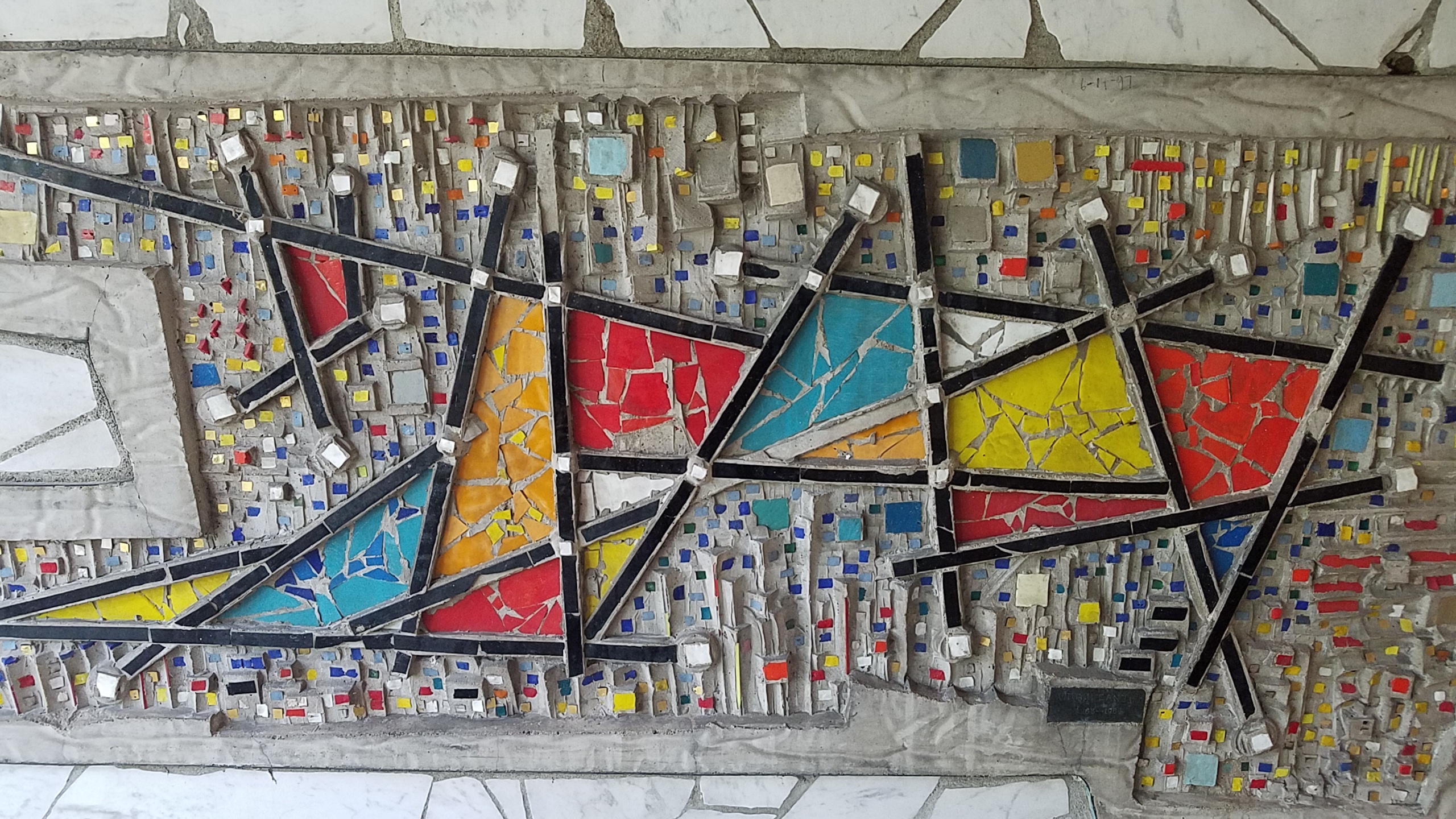
This is the first i have ever heard this mosaic. It’s worth saving.